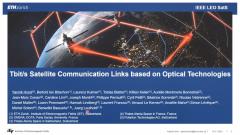
This video program is a part of the Premium packages:
Time-Packing as Enabler of Optical Feeder Link Adaptation in High Throughput Satellite Systems
- IEEE MemberUS $1.00
- Society MemberUS $0.00
- IEEE Student MemberUS $1.00
- Non-IEEE MemberUS $2.00
- IEEE MemberUS $50.00
- Society MemberUS $0.00
- IEEE Student MemberUS $25.00
- Non-IEEE MemberUS $100.00
Time-Packing as Enabler of Optical Feeder Link Adaptation in High Throughput Satellite Systems
This presentation focuses on the data rate that a High Throughput Satellite (HTS) system with fully regenerative payload can achieve when using an intensity modulation/direct detection optical feeder link. A low-order Pulse Amplitude Modulation (M-PAM) with time-packing is used to modulate the intensity of the laser diode beam, making use of an external Mach-Zehnder modulator. These M-PAM symbols are recovered on-board the satellite with the aid of a photodetector and are then encapsulated into the 5G radio frame of the access link. The M-PAM modulation order and the overlapping factor of time packing are jointly selected to tackle the impact of slowly-varying weather conditions. Moreover, the inter-symbol interference that time-packing introduces is mitigated in reception using a Viterbi equalizer. As expected, time-packing enables a finer granularity on the link adaptation capability of the optical feeder link, enabling to adjust its spectral efficiency according to the moderate attenuation that thin cloud layers introduce.
Time-Packing as Enabler of Optical Feeder Link Adaptation in High Throughput Satellite Systems
Joan Bas (Telecommunications Technological Center of Catalonia, Spain)
 Cart
Cart Create Account
Create Account Sign In
Sign In





